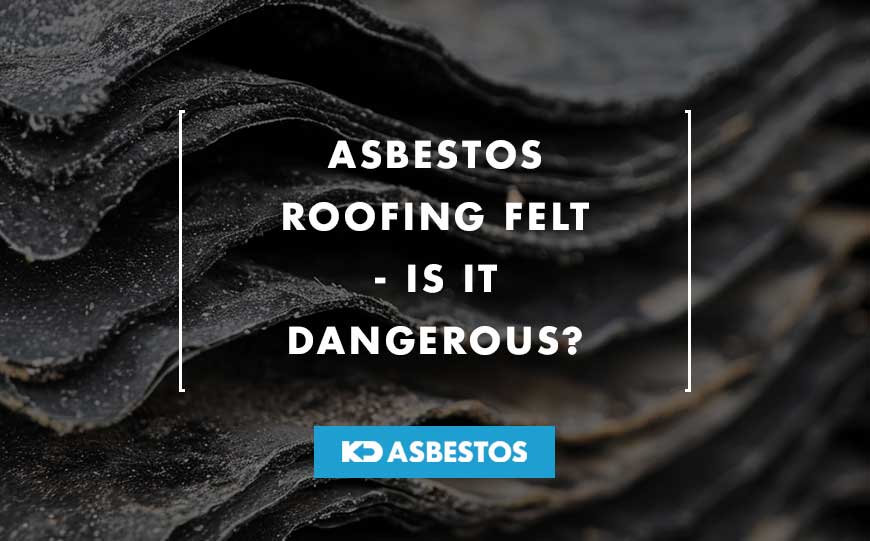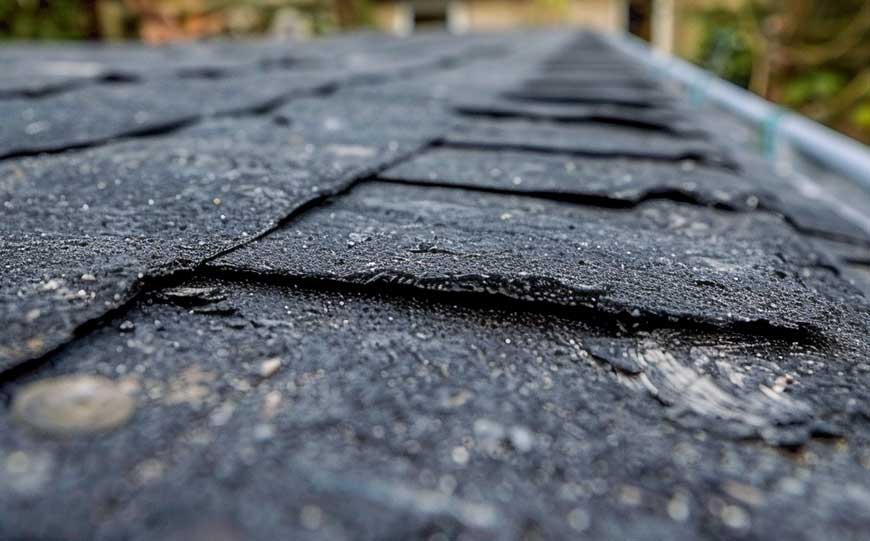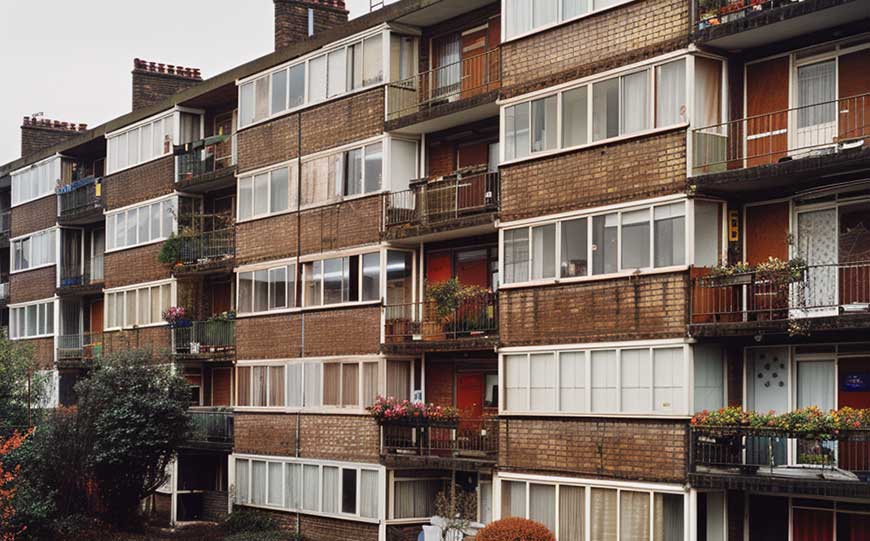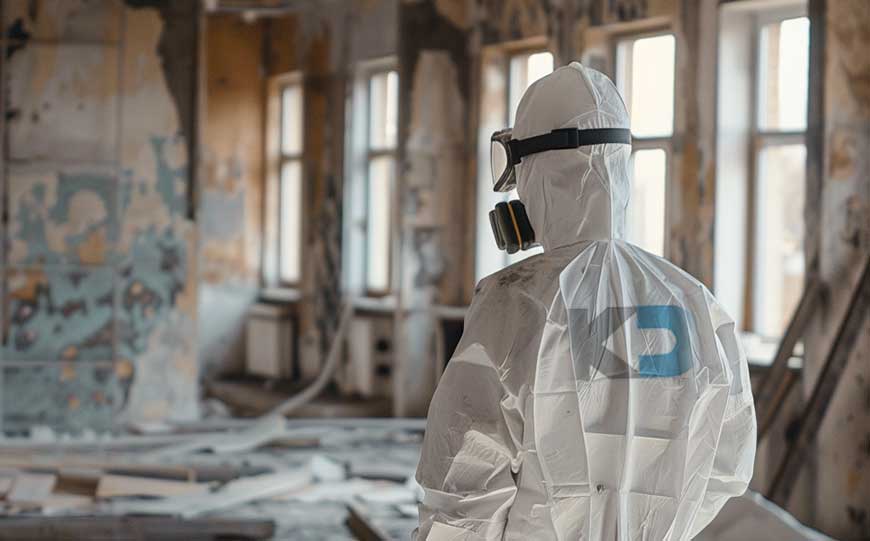
Asbestos roofing felt, a product once hailed for its durability and fire resistance, has come under scrutiny due to its potential health hazards.
But how dangerous is Asbestos roofing felt?
In this article, we’ll discuss exactly what Asbestos roofing felt is, where it was used and how you can identify it.
Also we’ll be delving into the exact dangers of this roofing felt and what to do if you find it on your property.
Table of Contents
What is Asbestos Roofing Felt?

Asbestos roofing felt, also known as asbestos felt or asbestos paper, is a type of roofing material composed of asbestos fibres and a bituminous or resinous binder.
It was widely used in construction for waterproofing flat or low-sloped roofs in residential, commercial, and industrial buildings.
Asbestos fibres were added to roofing felt to enhance its strength, durability, and fire resistance properties.
The fibres were typically mixed with bitumen or resin to form a sturdy, fibrous material that could withstand harsh weather conditions and provide long-lasting protection for roofs.
However, the use of asbestos roofing felt was outlawed due to health concerns associated with asbestos exposure.
Consequently, asbestos roofing felt is no longer manufactured or used in new construction projects, and efforts are underway to safely remove and replace existing asbestos containing roofing materials.
Where was Asbestos Roofing Felt Used?

Asbestos roofing felt was a popular roofing material that found widespread use in various types of buildings.
Here are some common locations where asbestos roofing felt was used:
Residential Buildings
In residential construction, asbestos roofing felt was commonly used on flat or low-sloped roofs of houses, apartments, and condominiums.
It provided an affordable and durable waterproofing solution for residential properties.
Commercial Buildings
Asbestos roofing felt was also widely used in commercial buildings, including offices, retail stores, and warehouses.
Its fire resistance and weatherproofing properties made it a preferred choice for flat or low-sloped roofs in commercial construction.
Industrial Facilities
Industrial buildings, such as factories, manufacturing plants, and warehouses, often utilised asbestos roofing felt for its durability and resistance to harsh environmental conditions.
It offered effective protection for industrial roofs, which are typically subject to heavy foot traffic and exposure to chemicals.
Institutional Buildings
Institutional buildings, such as schools, hospitals, and government facilities, also commonly used asbestos roofing felt.
Its ability to withstand wear and tear, along with its fire resistance qualities, made it a suitable roofing material for these types of structures.
Agricultural Buildings
Agricultural buildings, such as barns, storage sheds, and farmhouses, often relied on asbestos roofing felt for its affordability and resilience.
It provided reliable protection for agricultural structures against the elements
Other Structures
Asbestos roofing felt was also used in various other structures, including garages, carports, and outbuildings.
Its versatility and effectiveness made it a popular choice for a wide range of building projects.
How can Asbestos Roofing Felt be Identified?

Identifying asbestos roofing felt requires careful observation and, in some cases, professional assistance.
Here are some methods to identify asbestos roofing felt:
Visual Inspection
Asbestos roofing felt typically appears as black or grey paper with a fibrous texture.
It may have a smooth or slightly rough surface, depending on the specific manufacturing process.
Inspect the roofing material closely to look for any signs of fibrous or granular texture characteristic of asbestos.
Age of the Building
Asbestos roofing felt was commonly used in construction until the late 20th century.
If the building was constructed before the 1980s and has not undergone significant renovations, there is a higher likelihood that asbestos-containing materials, including roofing felt, may be present.
Professional Inspection
If you suspect that your roofing material contains asbestos but are unsure, it’s best to consult a qualified asbestos surveyor.
These professionals have the expertise and equipment to safely collect samples of roofing material for laboratory analysis.
Through microscopic examination, they can determine the presence and concentration of asbestos fibres in the sample.
If you require professional inspection or survey, for Asbestos, get in touch with us here at KD Asbestos.
Documentation
Reviewing building records and construction documents may also provide clues about the presence of asbestos-containing materials, including roofing felt.
Previous inspection reports or renovation records may mention the use of asbestos materials in the building’s construction.
How Dangerous is Asbestos Roofing Felt?

Asbestos roofing felt can pose significant health risks if disturbed or deteriorated, leading to the release of asbestos fibres into the air.
Here’s why asbestos roofing felt is considered dangerous:
Health Risks of Asbestos Exposure
Asbestos is dangerous due to the fibres that make it up.
Asbestos fibres are microscopic and can easily become airborne when asbestos-containing materials, such as roofing felt, are disturbed.
Inhalation of these fibres can lead to serious respiratory diseases, including asbestosis, lung cancer, and mesothelioma.
These diseases often develop years or even decades after initial exposure to asbestos.
Friability of Asbestos Roofing Felt
Asbestos roofing felt can become friable over time, meaning it can easily crumble or break apart when handled or disturbed.
As the roofing felt ages or deteriorates due to weathering, vibrations, or physical impact, asbestos fibres may be released into the surrounding environment, increasing the risk of exposure.
Potential Exposure Pathways
Exposure to asbestos fibres from roofing felt can occur during installation, maintenance, repair, or demolition activities involving the roofing material.
Workers and occupants of buildings with asbestos roofing felt may unknowingly inhale or ingest asbestos fibres, putting them at risk of developing asbestos-related diseases.
Lack of Awareness
Many people may not be aware of the presence of asbestos roofing felt in their buildings or the associated health risks.
As a result, they may not take adequate precautions to prevent exposure when working with or around asbestos-containing materials.
Failure to use proper safety measures, such as wearing personal protective equipment and following asbestos abatement procedures, can increase the likelihood of asbestos exposure and associated health hazards.
What to do if you Discover Asbestos Roofing Felt?

Discovering asbestos roofing felt in your building can be concerning, but it’s essential to take immediate action to address the situation safely.
Here’s what to do if you find asbestos roofing felt:
Avoid Disturbing the Material
If you suspect that your roof contains asbestos roofing felt, avoid disturbing the material to prevent the release of asbestos fibres into the air.
Refrain from performing any activities that could damage or disturb the roofing felt, such as drilling, cutting, or scraping.
Notify Building Occupants
Inform occupants of the building about the presence of asbestos roofing felt and the potential health risks associated with asbestos exposure.
Advise them to avoid the affected area and take precautions to minimise their exposure to asbestos fibres.
Consult a Professional
Contact a qualified asbestos abatement contractor or asbestos inspector to assess the condition of the roofing felt and determine the appropriate course of action.
These professionals have the expertise and equipment to safely handle asbestos-containing materials and ensure compliance with regulatory requirements.
For professional help with Asbestos, contact us here at KD Asbestos.
Conduct Testing and Evaluation
Consider conducting testing and evaluation of the roofing material to confirm the presence of asbestos and assess the extent of contamination.
A qualified asbestos inspector can collect samples of the roofing felt for laboratory analysis to determine the concentration of asbestos fibres present.
Develop a Management Plan
Work with the asbestos abatement contractor to develop a comprehensive management plan for addressing the asbestos roofing felt.
This plan should outline the steps to be taken to safely remove or encapsulate the asbestos-containing material and mitigate the risk of exposure to asbestos fibres.
Implement Safety Measures
Implement appropriate safety measures to protect workers and occupants during asbestos abatement activities.
This may include wearing masks and personal protective equipment, erecting containment barriers, and using specialised equipment for handling and removing asbestos-containing materials.
Dispose of Materials Properly
Dispose of asbestos-containing materials in accordance with local regulations and guidelines.
Asbestos waste must be packaged, labelled, and transported to approved disposal facilities by licensed asbestos contractors to ensure proper handling and disposal.
Monitor and Maintain
Regularly monitor the condition of the roofing material and conduct periodic inspections to ensure that asbestos-containing materials remain intact and undisturbed.
Implement preventive maintenance measures to minimise the risk of damage or deterioration of the roofing felt over time.
Conclusion
The discovery of asbestos roofing felt in a building requires prompt and careful action to mitigate health risks and ensure safety.
Asbestos exposure can lead to serious respiratory diseases, highlighting the importance of avoiding disturbance and seeking professional assistance.
By following proper protocols, including notification of building occupants, consulting with asbestos experts, and implementing safe removal or encapsulation methods, the risks associated with asbestos roofing felt can be effectively managed.
It’s crucial to prioritise safety at all stages of the process, from testing and evaluation to disposal and ongoing monitoring.
Through proactive measures and adherence to regulatory guidelines, the hazards posed by asbestos roofing felt can be addressed responsibly, safeguarding the well-being of individuals and communities.
For any and all information about asbestos, get in touch with us here at KD Asbestos.